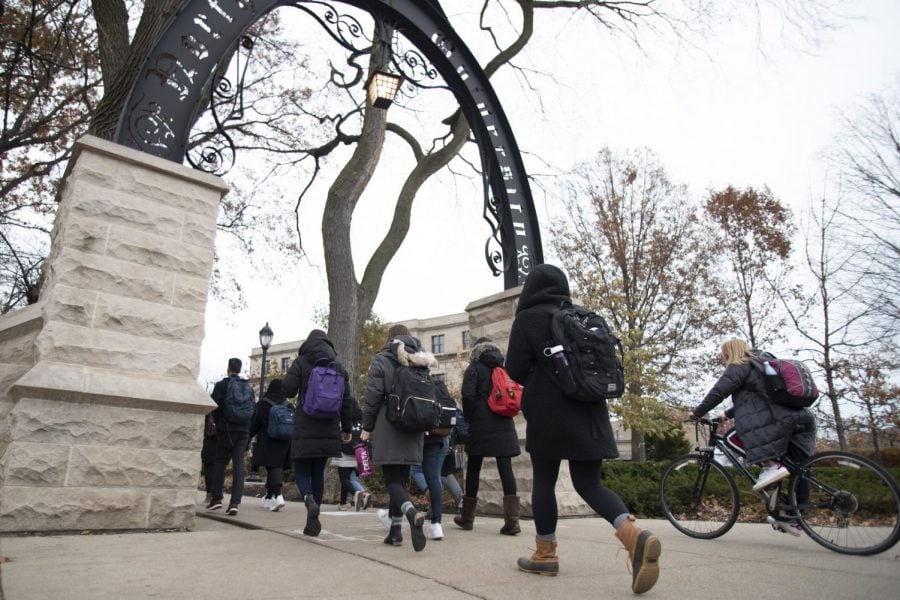Attendance requirements can be used to foster engagement, but students say it can sometimes be unnecessary
Colin Boyle / Daily Senior Staffer
Attendance-taking policy differences have taken the national stage, with educators debating over whether attendance requirements are ultimately harmful or beneficial. At Northwestern, professors see attendance requirements as a way to foster engagement.
November 13, 2018
Present or absent? Attendance is a straightforward question. How it’s taken, however, is not so simple.
For some professors, attendance is extremely important — research shows that students who attend class get better grades. For others, it’s necessary for group-work and class participation. And still, for others, attendance is neither taken nor required.
These policy differences have even taken the national stage, with educators debating whether attendance requirements are ultimately harmful or beneficial.
At Northwestern, professors also vary greatly in their attendance-taking styles.
Medill Prof. Patti Wolter said her attendance-taking methods do more than simply provide her with information about who is present.
“When I take attendance, the attendance-taking tools are explicitly for student engagement,” Wolter said.
Wolter uses Poll Everywhere, a software in which students can answer questions on an electronic device. These answers are then combined electronically and broadcast for the entire class to view.
She also collects notecards, asking students to write their response to a prompt.
“The notecards allow me to greet everybody at the door,” Wolter said. “It gives everybody a chance to sit and collect their thoughts before a prompt, which means far more people participate. Because not everybody thinks of an answer on the fly when I ask a question to the crowd, but if you’ve thought about it, and you’ve written it down, you’re much more likely to answer.”
Wolter added she believes attendance in lecture is crucial; so crucial, in fact, that she factors it into student grades.
“Most of the graded work is in lab, and I want there to be an incentive to come to lecture,” Wolter says.
SESP Prof. Lilah Shapiro, however, disagrees. She believes student attendance for lectures is less vital.
“Ideally they are there for lecture… but lecture slides can be downloaded. That’s not as crucial,” Shapiro said. “It is not necessarily so essential that the person be sitting in one room physically in order to hear the lecture.”
More important, she believes, is student attendance in participation-based classes. Most SESP classes, she added, are rooted in discussion or collaboration.
She said many of her own courses heavily involve group work, which makes it necessary for students to come.
“I try to give them a fair amount of time in class to work as a group…with the assumption that they are all going to be there,” she said. “So at least in class, I know everybody is able to make a contribution.”
She often takes attendance through a head count or a sign-in sheet, valuing it less as an engagement tool. However, Shapiro added that her methods vary based on what class she is teaching.
Students seem to agree that attendance policies should vary depending on what class is being taught.
Medill freshman Sarah Tani said her Spanish class is only 15 people — and for that reason she can understand the emphasis on attendance.
“The class can’t really function if it has less than 15 people in it, so it makes sense that they would need you to be there,” she said.
But for lectures, Tani believes there is no reason attendance should count toward her grade. Her EECS 110 course — a lecture-style class — does not take attendance. Although going to class is beneficial to her learning, she said it isn’t necessary to come all of the time.
Wolter, the Medill professor, said she often receives appreciative feedback for her attendance-taking methods in her Journalism 201-1 lecture.
“I often get comments from people, ‘thank you for doing these cards, it allows me to express my opinions and ideas, but I’m never going to be someone who speaks up in class.’”
For Wolter, however, attendance is more than just a tool for student engagement; it’s a way for her care for her students.
“If someone is missing a lot, it is a red flag for possibly other issues,” Wolter said. “It allows me, even if I have 200 students, to be a professor who can care for individuals.”


